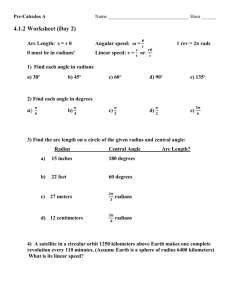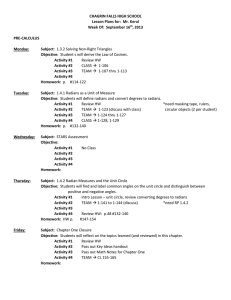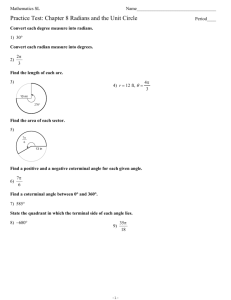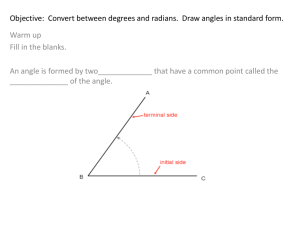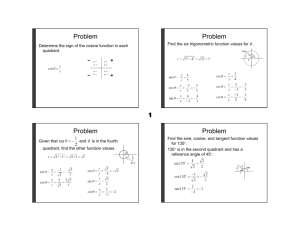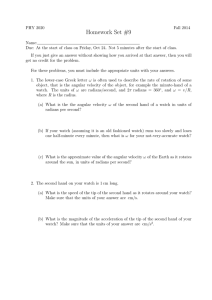Solution of ECE 202 Test 1 S13 ( )
advertisement
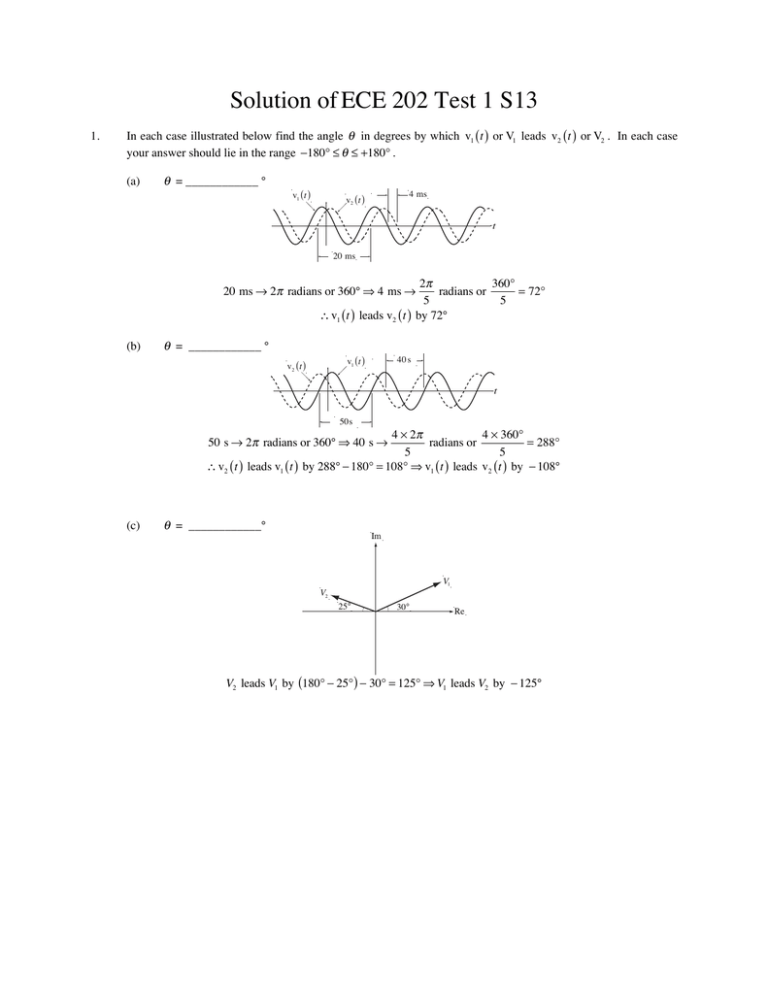
Solution of ECE 202 Test 1 S13 1. In each case illustrated below find the angle θ in degrees by which v1 ( t ) or V1 leads v2 ( t ) or V2 . In each case your answer should lie in the range −180° ≤ θ ≤ +180° . (a) θ = ____________ ° v1 ( t ) 4 ms v2 ( t ) t 20 ms 2π 360° radians or = 72° 5 5 ∴ v1 ( t ) leads v2 ( t ) by 72° 20 ms → 2π radians or 360° ⇒ 4 ms → (b) θ = ____________ ° v1 ( t ) v2 ( t ) 40 s t 50 s 4 × 2π 4 × 360° radians or = 288° 5 5 ∴ v2 ( t ) leads v1 ( t ) by 288° − 180° = 108° ⇒ v1 ( t ) leads v2 ( t ) by − 108° 50 s → 2π radians or 360° ⇒ 40 s → (c) θ = ____________° Im V2 V1 25° 30° Re V2 leads V1 by (180° − 25° ) − 30° = 125° ⇒ V1 leads V2 by − 125° 2. 3. Express each of the following numbers or expressions as a single complex number in polar form (magnitude and angle). (a) j24 = ____________ ∠ ____________° (b) 6 + j11 = ____________ ∠ ____________° 12.53∠61.3895° (c) 9∠48° = ____________ ∠ ____________° 2+ j 4.0239∠21.4349° (d) ( 3e )(1 − j ) = ____________ ∠ ____________° j 85° 24∠90° 4.2426∠40° Find the phasor equivalent of each of these voltages or currents. (Remember, the zero-angle reference for phasors is an unshifted cosine.) In each case the angle θ should lie in the range −180° ≤ θ ≤ +180° . (a) v ( t ) = 18 sin ( 200π t − 30° ) → V = ____________ ∠ ____________° 18∠ − 120° (b) i ( t ) = −13cos ( 20t + 140° ) → I = ____________ ∠ ____________° 13∠ − 40° Solution of ECE 202 Test 1 S13 1. In each case illustrated below find the angle θ in degrees by which v1 ( t ) or V1 leads v2 ( t ) or V2 . In each case your answer should lie in the range −180° ≤ θ ≤ +180° . (a) θ = ____________ ° v1 ( t ) 5 ms v2 ( t ) t 20 ms 2π 360° radians or = 90° 4 4 ∴ v1 ( t ) leads v2 ( t ) by 90° 20 ms → 2π radians or 360° ⇒ 5 ms → (b) θ = ____________ ° v1 ( t ) v2 ( t ) 30 s t 50 s 3 × 2π 3 × 360° radians or = 216° 5 5 ∴ v2 ( t ) leads v1 ( t ) by 216° − 180° = 36° ⇒ v1 ( t ) leads v2 ( t ) by − 36° 50 s → 2π radians or 360° ⇒ 30 s → (c) θ = ____________° Im V2 V1 35° 30° Re V2 leads V1 by (180° − 35° ) − 30° = 115° ⇒ V1 leads V2 by − 115° 2. 3. Express each of the following numbers or expressions as a single complex number in polar form (magnitude and angle). (a) j18 = ____________ ∠ ____________° (b) 4 + j13 = ____________ ∠ ____________° (c) 11∠38° = ____________ ∠ ____________° 2 + j4 2.4597∠ − 25.4349° (d) ( 3e )(1 − j2 ) = ____________ ∠ ____________° 6.7082∠21.5651° j 85° 18∠90° 13.60∠72.8973° Find the phasor equivalent of each of these voltages or currents. (Remember, the zero-angle reference for phasors is an unshifted cosine.) In each case the angle θ should lie in the range −180° ≤ θ ≤ +180° . (a) v ( t ) = 18 sin ( 200π t − 40° ) → V = ____________ ∠ ____________° 18∠ − 130° (b) i ( t ) = −13cos ( 20t + 120° ) → I = ____________ ∠ ____________° 13∠ − 60° Solution of ECE 202 Test 1 S13 1. In each case illustrated below find the angle θ in degrees by which v1 ( t ) or V1 leads v2 ( t ) or V2 . In each case your answer should lie in the range −180° ≤ θ ≤ +180° . (a) θ = ____________ ° v1 ( t ) 6 ms v2 ( t ) t 20 ms 3 × 2π 3 × 360° radians or = 108° 10 10 ∴ v1 ( t ) leads v2 ( t ) by 108° 20 ms → 2π radians or 360° ⇒ 6 ms → (b) θ = ____________ ° v2 ( t ) v1 ( t ) 35 s t 50 s 7 × 2π 7 × 360° radians or = 252° 10 10 ∴ v2 ( t ) leads v1 ( t ) by 252° − 180° = 72° ⇒ v1 ( t ) leads v2 ( t ) by − 72° 50 s → 2π radians or 360° ⇒ 35 s → (c) θ = ____________° Im V2 V1 55° 30° Re V2 leads V1 by (180° − 55° ) − 30° = 95° ⇒ V1 leads V2 by − 95° 2. 3. Express each of the following numbers or expressions as a single complex number in polar form (magnitude and angle). (a) j9 = ____________ ∠ ____________° (b) 2 − j11 = ____________ ∠ ____________° 11.18∠ − 79.695° (c) 7∠68° = ____________ ∠ ____________° 5+ j 1.3728∠56.6901° (d) ( 3e )( 3 − j ) = ____________ ∠ ____________° j 55° 9∠90° 9.4868∠36.5651° Find the phasor equivalent of each of these voltages or currents. (Remember, the zero-angle reference for phasors is an unshifted cosine.) In each case the angle θ should lie in the range −180° ≤ θ ≤ +180° . (a) v ( t ) = 18 sin ( 200π t + 40° ) → V = ____________ ∠ ____________° 18∠ − 50° (b) i ( t ) = −13cos ( 20t + 80° ) → I = ____________ ∠ ____________° 13∠ − 100°
